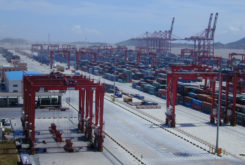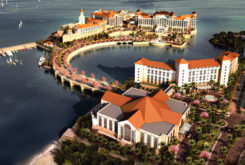Visitor numbers to Cabo Verde are continuing to grow year-on-year but there are fears that the focus on all-inclusive hotels restricts the development of local restaurants, cafes and other tourist sector businesses. It is vital that the government manages the industry in the long term interests of the country, as it is the most important part of the economy, accounting for about a fifth of GDP and has helped to transform Cabo Verde into a middle income country.
The country has many of the same attractions as other island destinations in the form of sun, sea and sand, but its location and climate give it warm weather year-round, while its political stability encourages foreign investment. Although there are some hiking routes, far too little has been done to promote the stunning mountainous landscape of the island interiors. The varied sea life, including nesting turtles, offers another attraction. The windy conditions for large parts of the year can deter some, although this is an advantage for some sports. Flights take about five hours from much of Western Europe and there is little jet lag because it lies in the same time zone as the UK.
Macauhub reported in late February that the country’s hotels hosted 765,000 visitors in 2018, with 4.9 million bed nights. These represent 6.8% and 7.4% increases respectively on the same period in 2017. Bed nights are the standard industry measurement of accommodation volume and simply refer to the number of nights’ accommodation per person.
The government hopes to boost visitor numbers above one million by 2020. The United Nations World Tourism Organisation forecasts that the number of tourists visiting African countries will increase from 54 millions in 2015 to 134 million by 2030 but there is certainly a lot of interest in Cabo Verde specifically. Research by the Global Travel Search Index found that Cabo Verde was the second most popular tourism destination search for Google users in 2017, behind Barcelona but ahead of Amsterdam.
More than 80% of all visitors come from Europe. More tourists come from the UK than anywhere else, with British visitors accounting for 30.2% of all bed nights, followed by Germany (12.1%), the Netherlands (11.2%), France (8.1%) and Portugal (7.4%). It will be particularly interesting to see how well the country can target the Brazilian market. With a common language and flight times as short as four hours, Latin America’s most populous country could prove an important source of visitors.
New hotels
The country has attracted the attentions of big international tour operators, including Thomas Cook and Tui and the number of hotel rooms in the country jumped from 5,891 in 2010 to 11,435 in 2016. In November, Riu Hotels opened the €70 million Riu Palace Boavista, its fifth hotel in the country and third on the island of Boa Vista. The five star hotel has 505 rooms, giving Riu a total of 3,480 rooms in the country, with about 2,500 employees and 235,000 visitors a year.
Luis Riu, the chief executive of Riu Hotels, said: “Cape Verde has been a unique experience. We faced all kinds of logistical and infrastructure challenges there, which we tackled using our accumulated experience and Cape Verde’s own determination to develop its tourist industry…We can now say that we have an excellent professional team, who more than make up for their lack of experience with their enthusiasm and appetite for learning.”
Macao businessman David Chow Kam Fai is still keen to develop a tourist complex at Gamboa and the Islet of Santa Maria at a cost of US$250 million. It is to include a hotel, casino and convention centre but although construction work is underway, progress on the venture has stalled since it was unveiled in 2015. The government of Cabo Verde seems particularly concerned about the status of his planned bank in the country.
The mayor of Praia Óscar Santos announced in February that a €85 million hotel complex would be developed at Gamboa beach but said that it was not the same project as David Chow’s scheme. It is being financed by Cabo Verdean and British investors, although they have not been named.
Geographical diversification
The industry could benefit from some accommodation diversification, as it is currently overly dependent on big hotel chains. A total of 89.3% of tourist bed nights were spent in hotels, with bed and breakfasts attracting 3.0%, tourist villages 2.9% and guest houses 2.6%. However, smaller establishments are more likely to be locally owned and so a higher proportion of the revenue they generate stays in the country. Most of the managers at the big hotels are Europeans.
Many hotel visitors stay on an all-inclusive basis and so spend relatively little money in shops, cafes and restaurants outside their hotels. Flights to the islands are expensive for independent tourists who do not want a package experience, partly because the holiday companies that fly tourists to the all-inclusive resorts are reluctant to supply visitors for independent hotels.
There is also some scope to spread visitors over a wider area, as the island of Sal attracted 55.1% of all bed nights and Boa Vista 36.3% in the first nine months of 2018. The government has identified the cruise ship market as one of the best methods of achieving this. In August, the national port operator, Enapor, launched a tender for the contract to project manage the construction of São Vicente cruise terminal, including a tourist village with shops and restaurants.
The terminal, which will have two berths, is expected to cost €29 million to develop, of which the Organization of Petroleum Exporting Countries’ Fund for International Development will provide €16 million, with the Orio Fund of the Netherlands providing €10 million in donor support. The Cabo Verdean government will contribute the remaining €3 million.
The government has changed the focus of its revenue raising activities. In January, it introduced an airport security fee of 150-3,400 escudos (US$1.5-35) on visitors arriving by plane in January, but simultaneously lifted its short stay visa requirements on visitors from the European Economic Area (EEA), which comprises the 28 member states of the European Union, plus four other European states. Visitors to Cape Verde from the EEA no longer need visas for stays of up to 30 days. It remains to be seen whether the changes will be revenue positive for government finances. The big winners from the switch will be cruise ship visitors who will not be required to pay either fee.
Obstacles to expansion
One of the biggest shadows over the archipelago’s tourism prospects in recent years was the fate of Cabo Verde Airlines. There was some doubt over the national carrier’s ability to sustain its operations but its internal flight services have now been spun off. Given Cabo Verde’s location and the domination of the state owned airline in connecting the islands to the rest of the world, its financial health is of huge concern.
A subsidiary of Icelandair Group, Loftleidir, announced at the end of February that it had bought a 51% stake in Cabo Verde Airlines via its offshoot Loftleidir Cabo Verde. Apart from operating services between European airports and the archipelago it hopes to develop the islands as a hub connecting different continents. The government of Cabo Verde expects to sell its remaining 49% equity in the airline at a later date.
The Icelandic firm submitted the binding offer in November, when managing director Árni Hermannsson said: “We have already participated in the restructuring of the company, and Cabo Verde Airlines’ operations are well suited to Loftleidir Icelandic’s projects around the world.” Hermannsson added: “The islands’ location is ideal for developing connecting flights. We have opportunities for well-organized connecting routes between Europe and South America on one hand, and West Africa and North America on the other, along with West Africa and Europe.” Loftleidir is particularly keen to make use of the expected rise in passenger numbers in African markets.
The government has tried to promote a positive environmental image, including by aiming to become one of the first countries in the world to rely on renewables for 100% of its power generation. As well as being environmentally sustainable, such an approach acts as a good tourist sector marketing strategy. However, local NGOs have also complained about the build-up of rubbish, particularly disused plastic, on the shores. The government has drawn up plans to ban single use plastic bags but a large proportion of the plastic on the country’s beaches comes from other countries. There have also been reports in the country that sand has been removed from many beaches to sell to the construction industry.
There has been some concern over many years that international hotel chains were benefitting too much from the growing industry and the Cabo Verdean government too little. At the same time, the industry places some strain on domestic power and water supplies. According to press reports in the country, only 58% of the population of Boa Vista has access to a modern toilet. Moreover, some hotel employees live in informal housing because travel times are too great for them to commute from their homes.
At the Forum de l’Investissement Hôtelier Africain conference in Marrakesh in February, the managing partner, hotels of consultants Horwarth HTL, Philippe Doizelet, said: “Economic stability and growth, combined with improved international links, could present a golden scenario” but added: “Water-supply, electricity distribution, internet connection and road networks remain the major constraints for further expansion of the sector.” The government has increased its roads budget in an effort to ease transport on the islands.(CLBrief)



